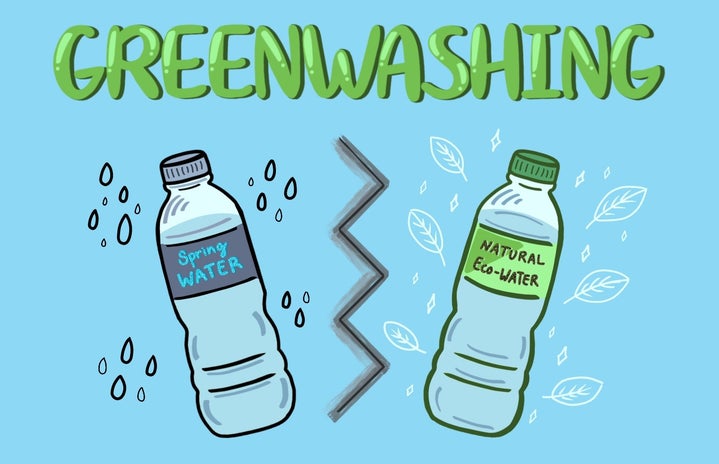In recent years many companies and businesses have come out with “sustainable” and “environmentally friendly” products, claiming that they are part of the green movement that has gained popularity. At first glance, you might think that this is a good thing. Companies are finally acknowledging climate change, the biggest threat to our existence! Unfortunately, not all of these companies are as “green” as they claim to be. In a world where sustainability has become a consumer trend, green efforts in companies are often simply marketing ploys to get consumers to spend more on their products. This misleading marketing process is called greenwashing.
According to Business News Daily, the term greenwashing was first coined in 1986 by environmentalist, Jay Westerveld. He observed how a hotel he visited in the 1980s urged guests to reuse their towels in order to help the environment. However, that same hotel produced tremendous amounts of waste in other areas, with no care for the environment. Westerveld concluded that the hotel wanted guests to reuse towels so that they wouldn’t have to pay the cost of daily cleanings. They were simply displaying this devious act as a “genuine” environmental effort.
Since the environmental movement has gained popularity greenwashing has become even more prominent. Companies that are perceived as “socially conscious” become more profitable, particularly among the Gen Z generation. Recent studies have found that Gen Z people are willing to pay more for ethically sourced, environmentally-friendly products. This allows companies to jack up their prices when they come out with a new “eco-friendly” line or product, even if they are not truly eco-friendly. If consumers are not actively questioning their purchases, it is difficult to differentiate truly eco-conscious from greenwashed products.
So what are some ways to spot and avoid greenwashing? One of the key characteristics of greenwashing in marketing is its use of vague terms, such as “green,” “sustainable,” “natural,” “non-toxic,” and “biodegradable.” Just because a product has any of these vague terms on its label doesn’t mean that it’s environmentally friendly, on the contrary. In fact, because there is no universal consensus for what terms like “sustainable” or “green” mean, brands are free to use these terms with little regulation. Likewise, if the packaging of a product is green colored, with plants or flowers surrounding its label with no apparent connection to the actual product, it is likely a greenwashing scam. Looking out for these warning signs can keep you from paying extra for a product that isn’t truly eco-conscious!
A well-known example of what greenwashing can look like for a well-known brand is H&M’s sustainability efforts. In 2019, H&M came out with a “conscious collection,” claiming that its clothes were made with ethically-sourced materials. They even added a sustainability tab to their website and recycling bins to their stores where customers could drop off unwanted clothing that they wished to recycle. In return, H&M could give customers a gift card to buy even more clothes!
This might seem like a brand actively trying to put in place environmental policies but the fact is, H&M is a fast fashion brand, and fast fashion brands are inherently unsustainable. As far as the recycling of clothes, environmentalist Elizabeth Cline researched this case and concluded that realistically only 1% of the clothes put in H&M recycling bins would end up being recycled. On the other hand, they incentivize customers to buy even more clothes with their new gift cards, ultimately producing that much more waste.
If you want to purchase truly sustainable clothes, it is important to research each brand and evaluate its values and policies. It is usually a good sign when they clearly list these on their website. If the wording is vague and ambiguous, the company is probably using these terms to appeal to young customers. If the company’s values are based on fact, such as guaranteeing plastic-free packing for shipped orders and ensuring that all of their workers are paid livable wages (invluding sourcing and factory workers!), then the company is likely truly sustainable. When in doubt you can always Google whether or not the company has been accused of greenwashing in the past!
I know from experience that it can be really difficult to consume ethically in today’s world where we are constantly bombarded with new products. While consuming only ethically-sourced products is not realistically feasible for everyone out there, when we do make an effort to buy green products, it is important that we spot and avoid greenwashing! Ultimately, companies respond to demand, and if we continue falling for greenwashing, they will keep doing it. By trying our best to avoid it, we will slowly shift consumption and hopefully one day force brands to apply actual sustainable policies!



